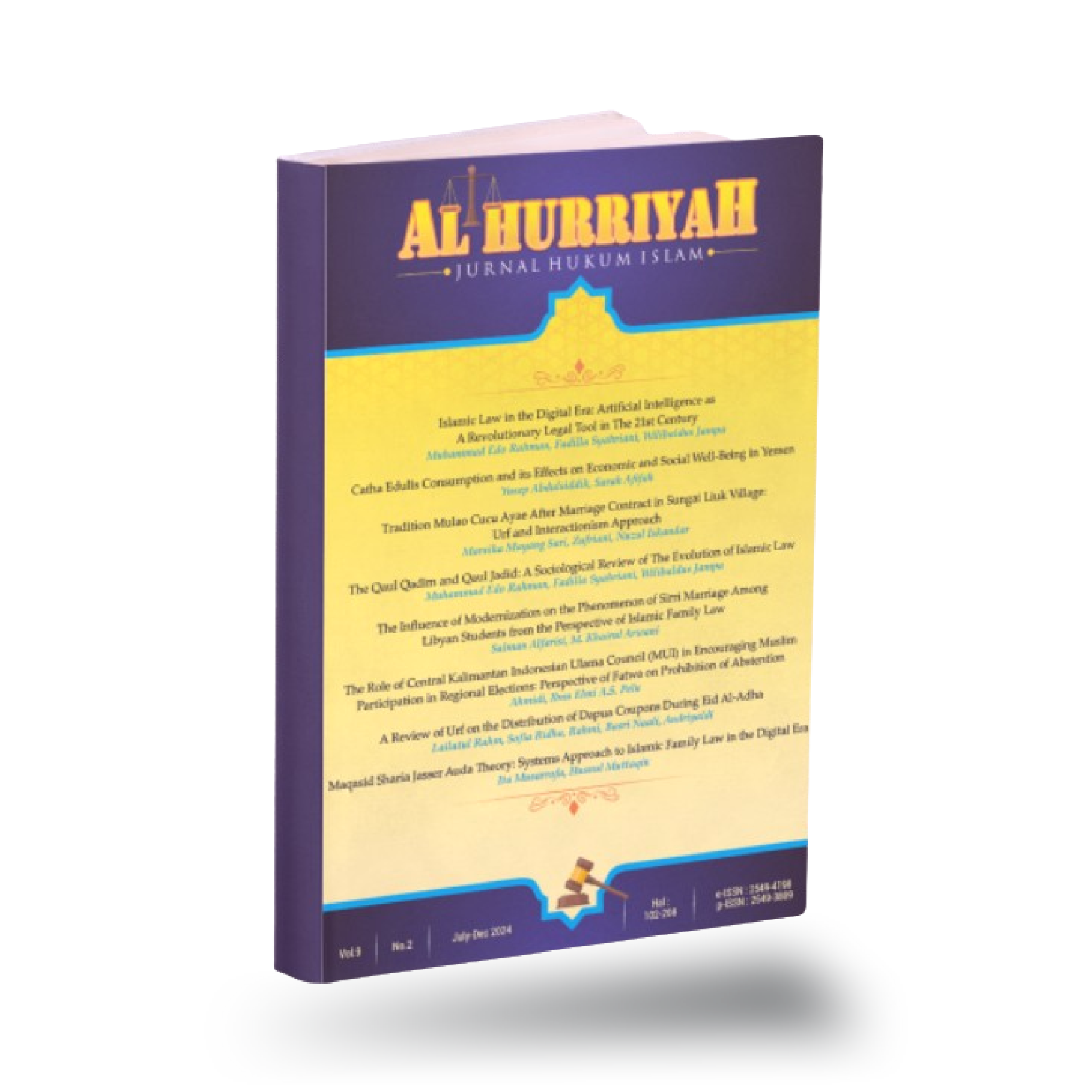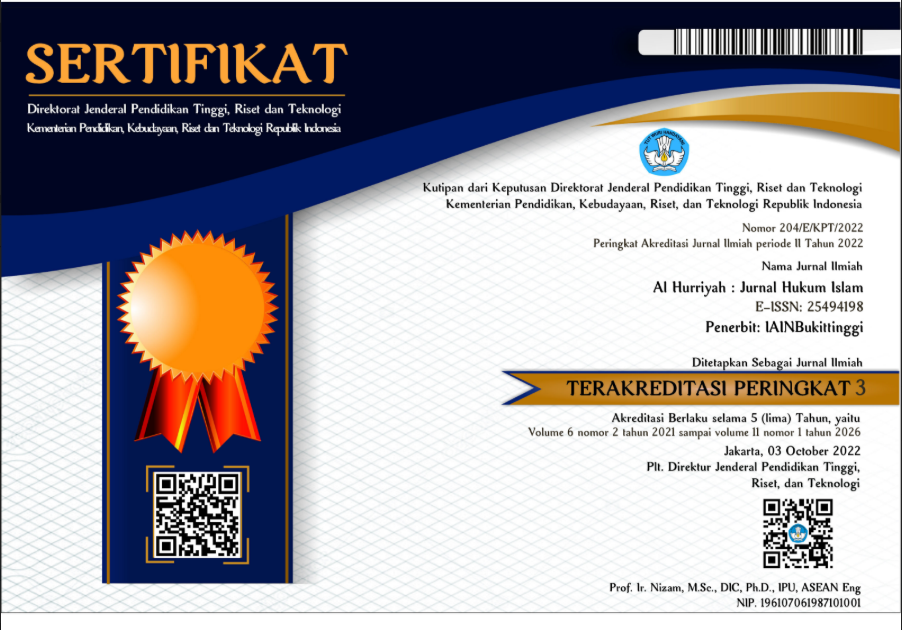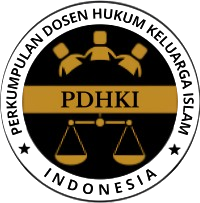Exploring Weton Calculation for Wedding Dates: Insights From Javanese Culture and Islamic Perspectives
DOI:
https://doi.org/10.30983/alhurriyah.v9i1.8150Keywords:
Weton, Tradition, Javanese, UrfAbstract
This study explores the practice of calculating weton, which has become deeply rooted in the culture of the Javanese community in the Wajak District of Malang Regency, namely, calculating weton to determine wedding dates. The research, employing qualitative methods, aims to investigate or construct claims or explanations behind the facts. Data collection techniques involve observation, interviews, and documentary studies, while data analysis employs deductive methods. The findings reveal that weton consists of a series of seven days in a week: Sunday, Monday, Tuesday, Wednesday, Thursday, Friday, Saturday, and five hari pasaran (market days) for Java, namely Legi, Pahing, Pon, Wage, and Kliwon. When calculating weton, Javanese people generally use three calendars that have been in existence for a long time: the Saka calendar, the Sultan Agung calendar, and the Pranata Mangsa. Weton is classified as al-‘urf al-fasid (a bad habit/tradition) when weton is seen as a talisman and a way to avoid misfortune. In Islam, belief in misfortune is called tathayyur.
References
Baghwi, Syaikh Farra’. Misykat Al-Mashabih. Semarang: Asy-Syifa, 1953.
Basri, Rusyda. “Nikah Dalam Al-Quran.” Jurnal Hukum Diktum 14, no. 2 (2016).
Bungin, Burhan. Metodologi Penelitian Kualitatif, Aktualisasi Metodologia Kearah Ragam Varian Kontemporer. Jakarta: PT RajaGrafindo Persada, 2007.
Daljoeni, N. Penanggalan Pertanian Jawa Pranata Mangsa: Peranan Bioklimatologis Dan Fungsi Sosiokulturalnya. Yogyakarta: Seri Terbitan Proyek Javanologi, 1983.
Djaelani, Bisri M. Ensiklopedi Islam. Yogyakarta: Panji Pustaka, 2007.
Edy. “Interview.” Edited by Mazroatul Akhiroh, July 10, 2022.
Fathani, Syaikh Daud Bin Abdullah. Idhoh Al Bab Li Muridi Al Nikah Bi Ahs Shawab. Singapura: Al Haramain, 1998.
Gafnel, Gafnel, Ismail Ismail, and Yaswirman Yaswirman. “Human Rights and Customary Law Analysis: Uncovering the Exploitation of Children and Women in Developing Countries.” Hakamain: Journal of Sharia and Law Studies 2, no. 2 (July 5, 2024): 174–85. https://doi.org/10.57255/hakamain.v2i2.325.
Hadi, Sutrisno. Metodelogi Research. Yogyakarta: Andi Offset, 1989.
Harahap, Khairul Fahmi, Amar Adly, and Watni Marpaung. “Perhitungan Weton Sebagai Penentu Hari Pernikahan Dalam Tradisi Masyarakat Jawa Kabupaten Deli Serdang (Ditinjau Dalam Persfektif ‘Urf Dan Sosiologi Hukum).” Al-Maslahah: Jurnal Hukum Islam Dan Pranata Sosial Islam 9, no. 2 (2021): 293–318.
Hasbiyallah. Fiqh Dan Usul Fiqh: Metode Istinbat Dan Istidlal. Bandung: Remaja Rosdakarya, 2013.
Hibatullah, Habib Akbar. “Penentuan Hari Perkawinan Berdasarkan Perhitungan Weton Di Desa Warukawung, Kecamatan Depok, Kabupaten Cirebon, Perspektif ‘Urf.” UIN Syarif Hidayatullah Jakarta, 2023.
Jawi, Syaikh Abdurrauf Bin Ali al-Fansuri. Tarjuman Al-Mustafid. Medan: Raja Pusblishing-Sumber Ilmu Jaya, 2017.
Khazin, Muhyiddin. Ilmu Falaq Teori Dan Praktek. Yogyakarta: Buana Pustaka, 2004.
———. Kamus Ilmu Falak. Yogyakarta: Buana Pustaka, 2005.
Khotimah, Eka Aulia Khusnul. “Perhitungan Weton Dalam Tradisi Pernikahan Di Desa Kanamit Jaya, Kecamatan Maliku, Kabupaten Pulang Pisau.” IAIN Palangkaraya, 2020.
Kusuma, Hilman Hadi. Ensiklopedia Hukum Adat Dan Adat Budaya Indonesia. Bandung: Alumni, 1977.
Laras. “Interview.” Edited by Mazroatul Akhiroh, July 11, 2022.
Malang, Badan Pusat Statistik Kecamatan Wajak Kabupaten. Dalam Angka 2020. Medan: CV. Rilis Grafika, 2020.
Maya. “Interview.” Edited by Mazroatul Akhiroh, July 13, 2022.
Musyarofah, Siti. “Praktik Perhitungan Hari Pernikahan Berdasarkan Weton: Studi Kasus Tradisi Perhitungan Weton Pada Masyarakat Dusun Gesikan, Kecamatan Ngluwar, Kabupaten Magelang.” UIN Sunan Kalijaga Yogyakarta, 2023.
Na’imah, Ifa Kutrotun. “Kontruksi Masyarakat Jawa Tentang Perhitungan Weton Dalam Tradisi Pra Perkawinan Adat Jawa (Studi Di Dusun Petak Desa Beged Kecamatan Ngayam Kabupaten Bojonegoro).” Universitas Airlangga Surabaya, 2017.
Nafi’, Muhammad Agus Yusrun, and Trio Minarsono. “Tradisi Perhitungan Weton Sebagai Penentuan Hari Pernikahan Pada Masyarakat Jawa Ditinjau Dari Hukum Islam (Studi Masyarakat Suku Jawa Di Desa Wonorejo, Kecamatan Mangkutana, Kabupaten Luwu Timur).” IAIN Palopo, 2023.
Rasyid, Sulaiman. Fiqh Islam. Bandung: Sinar Baru Algensindo, 2002.
RI, Departemen Agama. Al-Qur’an Dan Terjemahannya. Semarang: Al-Waah, 1989.
Rohman, Miftah Nur. “Perhitungan Weton Pernikahan Menurut Adat Jawa Dalam Perspektif Maslahah.” IAIN Ponorogo, 2016.
Salim. “Interview.” Edited by Mazroatul Akhiroh, July 16, 2022.
Shihab, M Quraish. Wawasan Al Quran. Bandung: Mizan, 2007.
Sholikhin, Muhammad. Ritual Dan Tradisi Islam Jawa: Ritual-Ritual Dan Tradisi-Tradisi Tentang Kehamilan. N.p.: Narasi, 2010.
Simanjuntak, Bistok Hasiholan. Analisis Curah Hujan Pada Sistem Pranata Mangsa Baru: Untuk Penentuan Pola Tanam. Salatiga: Universitas Kristen Satya Wacana, n.d.
Soekanto, Soerjono. Kamus Hukum Adat: Terdiri Dari 4163 Entri. Bandung: Alumni, 1978.
Sugiharto. “Interview.” Edited by Mazroatul Akhiroh, July 17, 2022.
Tsauri, M Najib. “Primus Inter Pares: Mengungkap Fenomena Praktik Istikharah Dan Perhitungan Weton Dalam Tradisi Pernikahan Di Lamongan.” Refleksi: Jurnak Kajian Agama Dan Filsafat 22, no. 1 (2023): 79–100.
Wahib, Khoirul. “Analisis Peranan Dan Pandangan Sesepuh Tentang Praktik Perhitungan Weton Sebelum Pernikahan (Di Desa Raci, Kecamatan Batangan, Kabupaten Pati).” IAIN Kudus, 2019.
Wawan. “Interview.” Edited by Mazroatul Akhiroh, July 5, 2022.
Zen, Chairul. Ensiklopedia Ilmu Falak Dan Rumus-Rumus Hisab Falak. Medan: Tim BHR Provinsi Sumatera Utara, 2008.
Zubaidah, Dwi Arini. “Penentuan Kesepadanan Pasangan Pernikahan Berdasarkan Perhitungan Weton.” Volgsgeist 2, no. 2 (2019): 207–23.
Downloads
Published
Issue
Section
Citation Check
License
Copyright (c) 2024 Mazro'atul Akhiroh

This work is licensed under a Creative Commons Attribution-ShareAlike 4.0 International License.
Authors who publish with this journal agree to the following terms:
- Authors retain copyright and grant the journal right of first publication with the work simultaneously licensed under a Creative Commons Attribution-ShareAlike 4.0 International License that allows others to share the work with an acknowledgment of the work's authorship and initial publication in this journal.
- Authors are able to enter into separate, additional contractual arrangements for the non-exclusive distribution of the journal's published version of the work (e.g., post it to an institutional repository or publish it in a book), with an acknowledgment of its initial publication in this journal.
- Authors are permitted and encouraged to post their work online (e.g., in institutional repositories or on their website) prior to and during the submission process, as it can lead to productive exchanges, as well as earlier and greater citation of published work (See The Effect of Open Access).





